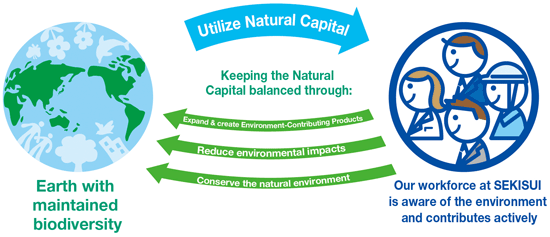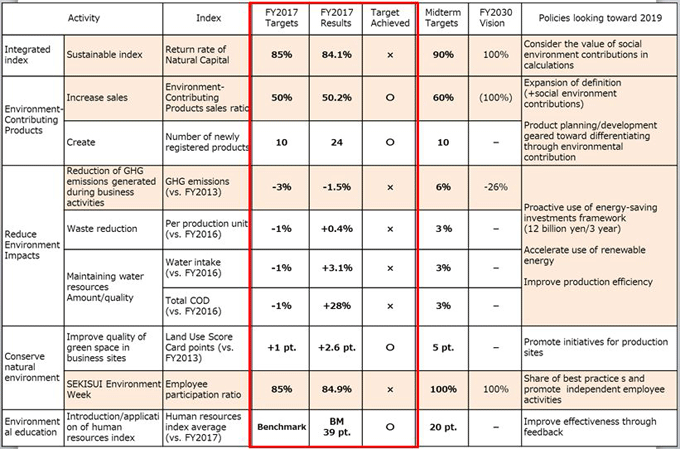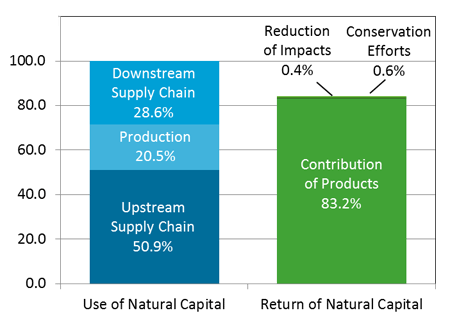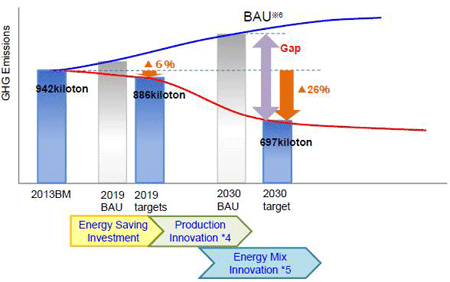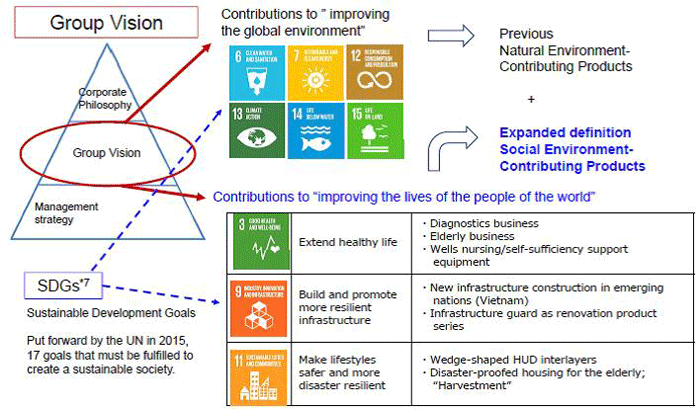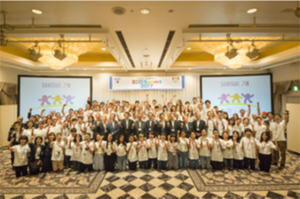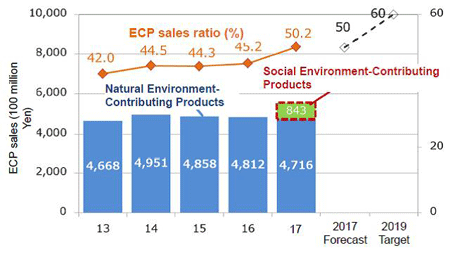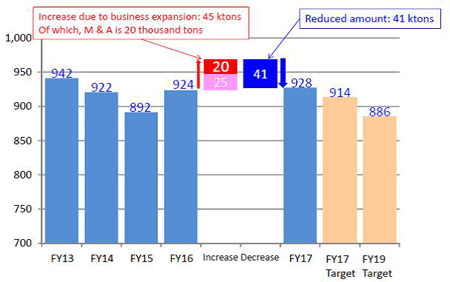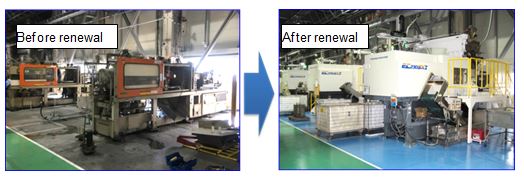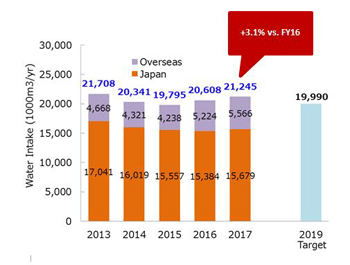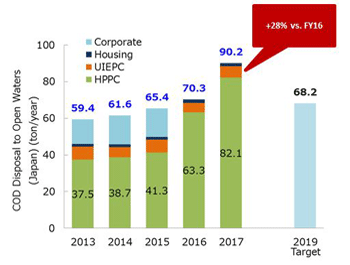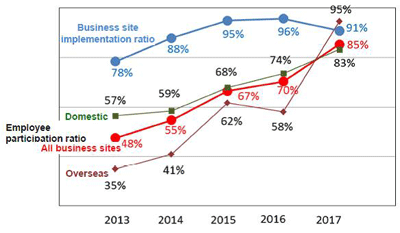SEKISUI CHEMICAL CO., LTD. (President and Representative Director: Teiji Koge; hereinafter, SEKISUI CHEMICAL) and its subsidiaries, are making efforts toward achieving their targets of its Environmental Midterm Plan “SEKISUI Environment Sustainability Plan: Accelerate” (FY 2017–2019), (hereinafter current environmental midterm plan).
FY 2017 Results Highlights
|
1) |
The progress of the Integrated Index is now being monitored. In FY 2017, the return ratio was 84.1% (up 7.7 points from the previous fiscal year). |
|
|
|
All business activities are evaluated using a point-based system to calculate the “SEKISUI Environment Sustainability Index” (natural capital return ration) which evaluates the positive and negative impacts on the natural and social environment. |
|
|
2) |
New “Environment-contributing Products” registration, now with a broader scope, has started. Sales ratio of 50.2% has been achieved. |
|
|
|
Twenty four Environment-Contributing Products have been registered with new contribution categories such as extending healthy life expectancy. Planning and production of products with focus on environmental contribution will be accelerated. |
|
|
3) |
Achieved SBT*1 Initiative certification for greenhouse gas long-term reduction targets (first in the chemical
sector). |
|
|
|
To achieve these long-term greenhouse gas (GHG) reduction targets, activities have begun to steadily realize our midterm target milestones. |
|
|
*1) SBT: Science Based Targets |
||
SEKISUI CHEMICAL Group is accelerating overall environmental initiatives, including the above, toward achieving its long-term environmental vision “SEKISUI Environment Sustainability Vision 2030,” as it aims to contribute to the goal of “the Earth with maintained biodiversity” (an Earth where SDGs have been achieved).
|
|
SEKISUI Environmental Sustainability Vision2030 |
|
|
|
|
|
|
|
SEKISUI CHEMICAL Group is aware that its business activities depend on resources (natural capital). |
|
1. FY 2017 Results Summary
In the environment midterm plan, three initiatives “expand and create Environment-Contributing Products”, “reduce environmental impact”, and “conserve the natural environment” have been set which are continued from the previous environmental midterm plan. However, measures to effectively implement these activities are being strengthened and actively promoted.
|
<Measures for Strengthening Effective Implementation> |
|
|
- |
Re-recognize diverse contributions of Environment-Contributing Products with its expanded scope. |
|
- |
Set up and provide energy saving investment incentives program (12 billion yen over three years) |
|
- |
Accelerate activities to achieve midterm goals and external commitment along with supply chain initiatives (SBT Certification) |
|
- |
Backup improvement toward effectiveness at the organizational and individual levels by implementing environmental personnel indicators. |
In FY 2017, as shown by the increased return of natural capital (up 7.7 points from the previous fiscal year), the foundation of our activities contributing to return was able to be built.
On the other hand, the following four issues were addressed going forward.
|
<Future issues> |
|
|
- |
Planning & development, and market creation of products that are differentiated through environmental contribution, from the viewpoint to create new values. |
|
- |
Reduce GHG emissions by making use of energy saving investment incentive program, to renew equipment and accelerate the use of renewable energy, etc. |
|
- |
Consider the use of energy saving investment incentive program to reduce impact on water resources |
|
- |
Promote reduction of impact and expansion of contribution through collaboration with supply chain |
Also, targets, results, and main issues of each activity are as follows.
|
Targets and Results |
|
|
|
Review and future approaches for the items in the shaded boxes on this chart are shown below. |
<Integrated Index>
Target not achieved: Natural capital return ration = 84.1%. Target was not met, but progress is steady.
|
|
Looking at the use of natural capital, results indicate that the supply chain accounted for 80%, and the largest contribution to the return of natural capital return was mainly due to Environment-Contributing Products.
Initiatives will be promoted in collaboration with the supply chain to reduce impact, and to increase contribution, sales and creation of Environment-Contribution Products will be further broadened.
<Long-term GHG Reductions; Certified by SBT Initiative>
In FY2017, to demonstrate that the midterm and long-term targets for the entire business and supply chain achieve the 2℃ target of the Paris Agreement are scientifically based ambitious targets, application for SBT Certification was submitted in March 2018. In June, the application was approved as the first company in the chemical sector.
|
Approved Targets |
||
|
|
- Scope1+2*2: |
Reduce greenhouse gas emissions by 26% by FY2030, compared to FY 2013 |
|
|
- Scope3*3: |
Reduce greenhouse gas emissions by 27% by FY2030, compared to FY 2016 |
|
*2) |
Scope 1: |
Direct emissions and fuel used in production processes, etc. by business |
|
|
Scope 2: |
Indirect emissions from energy resources, electricity purchased in production processes, etc. |
|
*3) |
Scope 3: |
Other indirect emissions, supply chain production, transport, customer use of product, disposal, etc. |
To reduce GHG emissions in Scope 1 and Scope 2, as shown in the graph below, initiatives on production reform and energy mix reform will be implemented, in addition to promoting energy saving investment program.
|
|
|
*4) |
Production reform: production innovation, reducing CO2 by reducing energy consumption |
|
*5) |
Energy mix reform: reducing CO2 by changing energy procurement, energy creation, and energy use |
|
*6) |
BAU (Business As Usual): increasing emission quantities along with increase in business activities |
With regard to Scope 3, in the case of SEKISUI CHEMICAL, it has been confirmed that substantial amounts of GHG are emitted in the procured raw materials and product use stage. In the procured raw materials, the reason for large emission was confirmed due to the inherent business characteristics of chemical manufacturers. On the other hand, for emissions at the product use stage, it was confirmed that considerable GHG emissions came through the use of energy from the homes that are sold.
Regarding the reduction of GHG emissions derived from raw materials, along with reconsidering selection criteria for selecting new materials, involvement of supply chain will be considered in activities to promote reduction of the largest 4 resin materials, and reduce emissions by 20% by FY2030 from FY 2016.
Regarding the reduction of GHG emission at the product use stage, energy reduction will be contributed by raising the sales ratio of homes with ZEH (net zero energy house) specifications to reduce energy during its use, and aim to reduce GHG emissions by 50% by FY2030 from FY 2016.
<Broadening the scope of environment-contributing products>
In FY 2017, the scope of SEKISUI CHEMICAL Group’s Environment-Contributing Products which were registered on the basis of SEKISUI CHEMICAL’s internal standards that produce high environmental contribution effects when used by customers, was broadened. In light of changes in SEKISUI CHEMICAL’s products and businesses, the Group vision was revisited. In addition to expanding contributions to “improving of the global environment”, to accelerate contribution to “improvement of lives of people around the world”, new categories with viewpoints on “Extend healthy life”, “Build and promote more resilient infrastructure”, and “Make lifestyles safer and more disaster resilient” have been expanded.
|
|
|
*7) SDGs: Sustainable Development Goals |
|
<Global Children’s Eco Summit 2017> |
|
|
In FY 2017, the Global Children’s Eco Summit 2017 was held in Japan’s Kanto region as an event to commemorate the 70th anniversary of the company’s founding. Forty-seven children of SEKISUI CHEMICAL Group employees from 13 different countries participated, deepened their awareness on environmental problems, and offered proposals about SEKISUI CHEMICAL’s environmental initiatives. The children proposed “Please provide teaching materials to study the environment for us, the next generation!” and the company president promised to provide environmental education (SDGs education) study tools to the next generation, globally. |
|
2. FY 2017 Results of Important Implementation Items and Next Steps
<Expanding and creating markets for Environment-Contributing Products>
|
Met target: |
Sales ratio 50.2% (natural environment: 471.6 billion yen, social environment: 84.3 billion yen) |
||
|
Met target: |
Number of newly registered products: 24 (natural environment: 4, social environment: 20) |
|
|
Target was achieved by expanding the scope to include social environment contribution, from a new environmental contribution perspective. Moving forward, market expansion will be aimed through planning & development of products that are differentiated through environmental contribution.
<Reducing Environmental Impact / GHG Emissions>
Did not meet target: GHG emission -1.5% (vs. FY 2013 BM)
|
|
Through reduction activities, emissions were reduced by 41,000 tons, but that was not enough to cover the 45,000 ton increase through M&A and production volume increases, and the target was not achieved.
Going forward, energy procurement options and actively use of renewable energy will be taken into consideration. Furthermore, project proposals applied for CO2 emissions energy savings investment incentive program (12 billion yen /three years) already have an aticipated reduction equivalent of 20,000 tons, and further future results can be expected.
|
Example Proposals of Energy Saving Investment Incentive Program |
|
|
- |
Update hydraulic injection molding machine to electric machines and introduce servomotors |
|
- |
Install large scale solar power generation for in-house use |
|
- |
Phase out all mercury lamps, etc. and change to LED lights |
|
Yamanashi SEKISUI (Co., Ltd.) |
|
<Reducing Environmental Impact / Water Resources>
Did not meet target: Water Intake Quantity + 3.1% (vs. FY 2016 BM)
Did not meet target: COD*8 + 28% (vs. FY 2016 BM)
|
|
|
|
*8) COD (Chemical Oxygen Demand): the amount of oxygen required for oxidation of water containing substances (oxygen consumption) and one indicator for water quality. Water quality with high COD containing high amounts of organic and inorganic substances is judged as being of poor quality. |
|
The water intake volume has been increasing due to production volume increases at some domestic sites and expansion in the number of overseas sites. COD emissions quantities at sites with large emissions also showed increases (within regulation limits).
Going forward, consideration is given towards applying environmental contribution investment towards reduction of water resources, and strengthening activities at three sites with high water intake quantities and four sites with high COD quantities.
<Conserving Natural Environment / SEKISUI Environmental Week>
Did not meet target: Employee participation rate 84.9% (Japan 83%, Overseas 95%)
|
|
SEKISUI Environmental Week was launched as a proposal from the Global Children’s Eco Summit 2012, and FY2017 marks the fifth year of this initiative where all employees participate in activities that contribute to the environment. |
Disclaimer
This press release may contain forward-looking statements. Such forward-looking statements are based on current expectations and beliefs and are subject to a number of factors and uncertainties that could cause actual results to differ materially from those expressed or implied by such statements due to changes in global economic, business, competitive market and regulatory factors.

